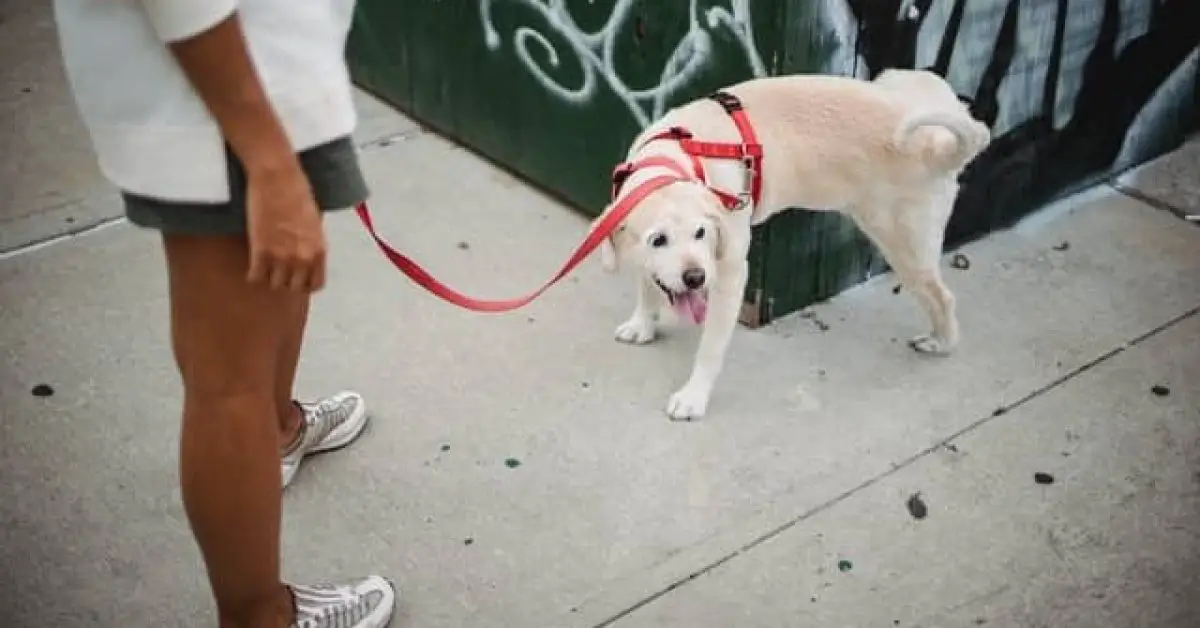WHY IS MY DOG PEEING EVERY 5 MINUTES?

We all know that dogs can bring immeasurable joy into our lives. But we also know that they come with a lot of responsibilities. One of the problems we can face as dog parents is that of incessant peeing. It’s very annoying when you have a dog especially an adult dog peeing all over your house. Believe it or not, most dog parents face the problem. The chorus of “my puppy keeps peeing every few minutes” or maybe in your case an older dog is a well know one. So the query “why is my dog peeing every 5 minutes” is a valid one that needs to be answered.
A dog can be peeing every 5 minutes due to some health problems or behavioral problems. The health problems are usually a result of malfunctioning or non-functioning of the organs for discharging liquid waste and the behavioral problems can be as a result of patterns or bad habits which the dog has developed.
..................................
ACCESS OUR DOG VIDEOS TRAINING LIBRARY FOR FREE
Now before we explain the above in more detail, there are some things we need you to be clear on.
Puppies have small bladders and their bladder control is still developing. You can say that they don’t have much control over that functionality, so, you will find that young puppies are peeing every now and then. For that young puppy, in its mind, it would have held onto that pee for a long time, but to us, they are just messing up our house.
On the other hand, young dogs and adult dogs have bigger bladders and much better bladder control than puppies. On average an adult dog can do an average of three pee trips a day. That translates to an equivalent of at least 8 hours of hold pee per day.
That is why an adult dog can pee before going to sleep, and sleep well throughout the night without bothering anyone just to wake you up early in the morning for another pee session.
A puppy would not be able to do this. On average, a puppy needs to pee every 10 to 30 minutes of drinking water.
Puppies under 6 months of age are expected to pee every one hour and then two hours as they grow, so if you have a “4 month puppy peeing a lot“, it shouldn’t be much of a surprise for you. A good way of mapping out the progression would be to use the dog’s month as a count. For example, make sure a 1-month-old dog pees every one hour, while a 3-month-old dog pees every 3 hours.
Any puppy that defaults from this standard needs to be checked to confirm there is nothing wrong with them. This is just a standard for checking on the puppy and not a rule.
Following this method, you should be able to detect early enough if your puppy or dog is having a peeing problem. The problems are usually two folds. It is either the dog is have a health problem that is causing him or her to pee every five minutes or a behavioral problem that is leading to the same problem.
A vet doctor is usually your best bet in dealing with the health problems while a trainer or an animal behaviorist would be your best bet in dealing with behavioral problems.
MEDICAL PROBLEMS TO “WHY IS MY DOG PEEING EVERY 5 MINUTES”.
Medical problems can be the reason why your dog is peeing every 5 minutes. This is usually the first thing to check if you observe incessant peeing in your dog and is usually divided into two categories medical diseases and medical conditions.
Medical diseases can be defined as external afflictions from germs, bacteria, viruses, etc. which can lead to a dog peeing every 5 minutes while medical conditions can be defined as a maldevelopment of an organ involved in peeing, making it not to function as it should and hence making your dog pee every 5 minutes. This is usually referred to as incontinence. A quick note here, incontinence can also be a sign of some diseases but generally, the problem incontinence comes with can be there without any associated disease.
Medical conditions or Incontinence.
Urinary incontinence caused by ectopic ureters.
Common in female dogs, this is usually caused by an abnormal opening in the urethra. This makes the dog leak urine every now and then without even realizing it’s doing so. Some breeds that are prone to this problem are Golden Retriever, Labrador Retriever, Miniature Poodle, Collie, Welsh Corgi, Fox Wire-haired Fox Terrier, West Highland White Terrier, English Bulldog, Newfoundland, and Siberian Husky.
Urinary incontinence caused by decreased urethral closure pressure.
As the name implies, the normal urethral opening is not properly closed after urination leading to leakage of pee, even though the dog is unaware, this particular situation can lead to variation in intensity, occurrence, and duration of each leakage situation.
Hormone-responsive incontinence.
Mostly occurring in female dogs, this is usually as a result of neutering the dog, very common in large dog breeds and can take some time before it shows in the dog (months or even years after neutering).
As you can see the three incontinence scenarios are common in female dogs, so if you have been wondering “why is my female dog peeing a lot“, the scenarios stated above is one of the common causes.
Age-related incontinence.
As the name implies, this incontinence is a result of aging in dogs. As they age, their muscles including the ones controlling the urethra become weaker and weaker. Other failures in functionality like neurological failures also make the pee more and more pronounced in the dog.
Blockage of the urethra.
Simply put, the dog is unable to completely empty its bladder because of some blockage. This blockage leads to pressure building up which can force leakage from another part of the bladder and also lead to damage.
If you are asking yourself why “my dog keeps trying to pee but only drops come out” then it is likely that he or she is suffering from the blockage of the urethra and it needs to be treated fast as this is one of the signs that the condition is in an early stage.
Incontinence generally is best handled by an expert vet and treatment usually boils down to surgery, medication, or hormone replacement therapy.
Medical diseases
UTI.
Short for Urinary Tract Infection is an infection that can cause your dog or puppy to pee every now and then. This infection comes from bacteria from the feces of an infected dog or a generally unhygienic environment. The most common bacteria that causes UTI is the Escherichia coli, even though there are many others.
It is important to note that even though UTI is a broad term used to identify a wide range of infections, most use cases of the term as we are doing here are in reference to the dog’s bladder.
The good thing about Urinary tract infections is that they are easily treatable especially when the bacteria causing the problem has been identified. A simple urine sample is usually all your vet doctor needs to identify the culprit.
Treatment is usually done either by giving the dog antibiotics or by spaying/neutering the dog.
Kidney Infections.
This is usually the infection of either one or both of the dog’s kidneys by a bacteria, these bacterias are usually ones that migrate from the dog’s infected bladder through the ureter to the kidneys. This infection can cause your dog or puppy to pee every 5 minutes.
Just like urinary tract infections, kidney infections can also be treated by the use of prescribed antibiotics.
Kidney Stones.
Also known as metabolic kidney stones. These stones get formed in a dog’s kidney due to blood or urinary imbalances in their ph levels. The most common kidney stones are calcium oxalates. Other types would be a combination of magnesium, ammonium, and phosphate.
These stones can grow to the extent of affecting normal kidney functions and can lead to your “puppy peeing every 10 minutes” or 5 minutes.
Some dog breeds like Miniature schnauzer, Lhasa apso, Shih Tzu, and the Yorkshire terrier are prone to kidney stones
Treatment for removing kidney stones always involves some surgical procedure. It’s important to note that a dog may have kidney stones for a long time but as far as they don’t obstruct kidney functions, your dog would still be perfectly ok.
Bladder Stones.
Also known as uroliths or cystic calculi, are rock-like formations of minerals that develop in the urinary bladder. It can occur as a large single stone, small stones of different ranges, or sand-like formation. But most times they are found in the dog’s blabber as a combination of all three.
As with kidney stones, bladder stones can exist in the bladder but if they don’t grow too large or start affecting the bladder functionality, the dog will be ok. Immediately they start affecting the dog’s functionality simply by developing in regions where the urine is supposed to pass through and obstruct the flow. Your dog will start experiencing the need to pee every 5 minutes.
As with kidney stones, bladder stones are mainly removed through a surgical procedure.
Diabetes.
Basically, this is a disease where the pancreas is not producing enough insulin to process the glucose in the body or generally speaking the blood sugar, or in the extreme, the body just becomes insensitive to insulin. The two situations still lead to the same thing, high blood sugar in the body which makes a dog’s kidney shed more water, leading to them wanting to pee every now and then. It also makes a dog drink lots and lots of water leading to the cycle repeating itself over and over again.
It’s worth noting that even though there is some medication for diabetes, there is no real cure for it. There will also be the need to change the dog’s diet completely to accommodate the situation.
Tumors.
A non-cancerous tumor in a dog’s brain can be situated such that it applies sufficient pressure to the pituitary gland, which in turn causes the brain to send misleading signals to the rest of the body, causing the hormone levels to shift from normal and making your dog to pee frequently.
Medications.
Sometimes the medications prescribed to cure a dog of an alignment can lead to other side effects. One of those side effects is your dog peeing every 5 minutes. Of course, most vet doctors would alert you to possible side effects of the medications they prescribe for your dog, and also most times these side effects are temporary.

BEHAVIOURAL PROBLEMS TO “WHY IS MY DOG PEEING EVERY 5 MINUTES”.
So if you have gotten your dog checked and the cause of your dog peeing every 5 minutes is not a medical one, then it is obviously going to be a behavioral problem. Below are some of the obvious reasons why your dog would pee frequently.
No Proper Potty Training.
Let’s put it out there. You have not properly trained your dog.
This is even more true for puppies. At this stage, they do not know what is expected of them, more so, they have very poor control of their urination system. The onus of what they should be doing and what they shouldn’t lie squarely on you.
The first thing you should be doing is to adapt a training method and be consistent with it for a long time no matter what happens. This means sticking to a particular schedule as your dog or puppy’s age requires, providing appropriate spots where your pooch can pee, and offering rewards anytime your dog or puppy adapts to the requirement.
Keeping at this schedule always does come with positive results in the long run, on the flip side, you will have a messed up indoor with your puppy peeing incessantly if you don’t stick to the schedule.
Anxiety.
One of the ways in which a dog, especially small dogs release tension when they get really scared is by peeing.
As a behavioral problem, it is harder to fix because the cause is not a bacteria or a malfunctioning organ. It has to do more with stimulation triggers, hormonal releases, and expectations.
To deal with this problem, a lot of exercise, socialization, and trying to link the anxiety triggers from negative to positive feelings are required. Also providing the dog with its own private spot in the house can have a very positive effect on the problem and the dog or puppy in general.
Also put into consideration, the possibility of you being the one causing anxiety to your dog. For example, have you shouted at your dog and found out that your dog pees on itself. There is also the possibility that your dog may be suffering from separation anxiety.
Read more about DEALING WITH SEPARATION ANXIETY IN DOGS here.
All these indicate that you may have more work to do with your dog than you probably thought of earlier. A lot of positive reinforcement, encouragement, and relationship building is required here. In most anxiety cases, there is the need to consult an animal behaviorist or a professional dog trainer to assist you in dealing with the problem.
Attention Seeking.
This is actually the simplest reason for this behavior. What other motivation does a dog or a puppy need than to do whatever they need to do to get your attention? Sure the attention might not be a positive one but we bet that your dog or puppy would prefer that attention to not getting any from you.
Thankfully, this one is an easy problem to solve. What can you do about it? Simply start giving your dog the attention they want.
Schedule, exercise and training sessions with your dog. Go on that long-overdue walk with them. Go to some park and play fetch with them. Just plan something that you two can do together daily and your dog would be ok.
Also, consider investing in some dog toys. Some dog toys especially puzzle toys help not just to stimulate the dog or puppy physically, they also help to stimulate them mentally which helps to keep your dog in a balanced state of mind.
You can read more on the BEST CHEWY DOG TOYS here.
Dog Breed.
That your “8 week old puppy peeing a lot” every five minutes or that elderly dog peeing every 5 minutes can be a result of the dog’s breed. Yes, some dog breeds are more disposed to peeing more frequently than others. Examples of some of these breeds are Pekingese, Jack Russell terrier, Bichon Frise, Yorkshire terrier, Maltese, Pug, Beagle, Bassett Hound, Chihuahua, etc.
So there you have it. All the possible answers to the question “Why is my dog peeing every 5 minutes?” The next question is what can you do to manage the situation.
STRATEGIES FOR DEALING WITH YOUR DOG PEEING EVERY 5 MINUTES
Get a Crate for your dog: Aquiring a crate and doing crate training for your dog can help to stop them from peeing frequently. You see, when a dog is well trained for the crate, he or she will get to see the crate as a personal space, somewhere they have access to and where no other person or pet can get into.
Naturally, they would want to keep the place neat, so you will find them avoiding peeing or defecating in their crates.
Off course, you still have the responsibility of taking your dog to pee according to your dog’s age and needs. Use the guide above that we have already mentioned to know when to take out your dog or puppy to pee.
Finally, mistakes do happen especially at the early stage of your training, be sure to clean up after your dog and make sure that the spot is clean and the smell is completely taken off. The reason being the presence of the smell can act as a trigger for the dog to continue peeing there.
Read more about dog crates here BEST CRATES FOR DOGS
Invest in a dog bed: A dog bed can be used to achieve the same thing that a dog crate is expected to do, but in addition, your dog gets the comfort and aesthetics, and for dogs with bone problems or arthritis the terupatic healing of using a dog bed.
Read more about dog beds here WHAT IS THE BEST DOG BED ON THE MARKET?
Consider Belly Bands and Diapers: This option does not really do much to stop your dog from peeing frequently, but they help to limit the mess that peeing everywhere causes. Belly bands are usually for the male dogs while diapers are for the female.
The aim is to absorb the pee from the dog into the absorbent materials instead of allowing them to make a mess of it everywhere. You will have to take up the responsibility of changing the belly bands and diapers regularly, but truth be told, this would be far better than cleaning the house floor regularly.
Thoroughly clean and remove odors from any pee spot: We as humans cannot really determine the logic which goes into a dog choosing a spot to pee on, but we all know that if a dog pees in one spot, there is a high likelihood that they would come back to that spot to pee.
Hence, if they pee anywhere in the house, it is your responsibility to clean such a place thoroughly. Use a high-quality odor-neutralizer and clean thoroughly till you cannot perceive any odor. If possible, go the extra mile and clean the spot again. Our dog’s nose can perceive things on a higher level than we can, but the addition of odor-neutralizers and proper cleaning will definitely make such a pee not not so attractive for future peeing.
Maintain a Potty Schedule: Setting and trying to keep a potty schedule helps your dog. He or she gets to understand what is accepted around the house and more importantly starts to prepare themselves mentally for the schedule you are setting for them. As they grow and start having more control over the organs, especially the ones for peeing, they would likely not want peeing incidents to affect their relationship with you.
DOG CARE
DOG PRODUCTS
DOG BREEDS

Hi, I am Charles Nwankwo Editor-in-Chief, Mydoggything.com. Gleaning from Professional Dog Trainers, behaviorist, Registered Veterinarians, and Breeders. We are passionate about making dog care easy for you. My job is to make sure that you get the best-updated dog care information to understand and take care of your dog or dogs.








